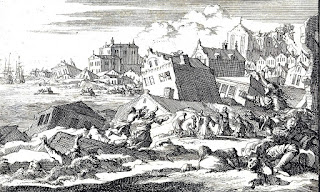 |
| http://amzn.com/B00I6KOKL6 |
From the book: Samuel Pepys' Penny Merriments, Being a Collection of
Chapbooks, full of Histories, Jests, Magic, Amorous Tales of Courtship,
Marriage and Infidelity, Accounts of Rogues and Fools, together with Comments
on the Times. Selected and Edited by Roger Thompson of the University of
East Anglia at Norwich, 1977.
 |
| Merchantman being attacked by Pirates |
Whew, what a mouthful. Our titles these days are much
shorter, with less syllables, easier to remember. To remember this, I simply
refer to it as: Penny Merriments, a tome I found in a used bookstore and
considered it a great find. It has all sorts of wonderful information, like
recipes to make one beautiful, or a recipe for the newest way to roast a hare.
It sends me right back into the era of my choice...
17th century England started out with traders going to
far distant shores, but the cost was extensive. Spices were gathered through
the Levant Company (owned by noblemen and gentlemen of quality) and the
fledgling East India Company. As the century moved forward, their ships went to
places already taken by the Spanish and Portuguese.
 |
| First Anglo/Dutch War |
The Dutch East India Company (VOC) began at about the
same time as England's, but they weren't hampered by the religious upheaval and
civil wars England endured during the first half of the century. The Dutch VOC
had a leg up on English merchant shipping until Cromwell decided enough was
enough and went to war with The Netherlands. This is known as the First Anglo/Dutch war
(1652-54), and fought entirely at sea. This war were over trade, who could
monopolize which ports in the East and West Indies.
With that said, the recipes below show an inordinate
amount of spices, which were very costly. During the reign of King James I, a
fight to near death took place between VOC and English Merchantman in the South
Seas that decimated the nutmeg crops on Pulo Run Island, in the Banda
archipelago. A once rich source of nutmeg, it never fully recovered.
Citrus fruits, dates, pepper, cotton cloth, and other
fruits and spices were trekked across the desert sands to ports the Levant held
in the Mediterranean, then imported via ship to London. Once these commodities
hit the London markets, they proved costly for the middling English household.
 |
| Fleet of East Indiamen at Sea |
The below recipes can only come from later in the 17th
century, and were directed to the more well-to-do. Middling folk who could
read, enjoyed the thoughts of these, though...
"To Roast a
shoulder of mutton with Oysters the best way. Take one not too fat nor too lean, open it in divers
places, stuff your oysters in with a little chopt pennyroyal (mint or basil),
baste it with butter and claret wine, then serve it up with grated nutmeg,
yolks of eggs, ginger, cinnamon, butter and red wine vinegar."
"To Stew a
Leg of Lamb the best way.
Slice it and lay it in order in your stewing-pan,
seasoned with salt and nutmeg, adding a pound of butter, and half a pint of
claret, with a handful of sliced dates, and the like quantity of currants, and
make the sauce with the yolk of two eggs, a quarter pint of verjoice (acid
juice from sour or unripe fruit), and two ounces of sugar. Boil them up, and
put them over the meat, serving up hot together."
"The Art of
Beautifying the Hands, Neck, Breast and Face: Harmless and Approved, with other
Rare Curiosities.
To make the hands arms white, clear and smooth. Take a
quarter of a pound of sweet almonds, blanch and bruise them, with a quarter of
a pint of oil of roses, and the like quantity of betony-water (plant of the
mint family): heat them over a gentle fire; and then press out the liquid part,
and it will serve for either hands or face anointed therewith."
"To take away
Freckles, Morphew (scurfy skin) or sunburn.
Steep a piece of copper in the juice of lemon till it be
dissolved (the juice), and anoint the place with a feather morning and evening,
washing it off with white wine." (Not sure how that one worked.)
"To take off
any scurf from the hands and face.
Take water of tartar, that is, such wherein calcined
(burnt to a powder) tartar has been infused, anoint the place, and wash it as
the former (with white wine)."
"To sweeten
the Breath, and preserve the Teeth and Gums.
Boil a handful of juniper berries, a handful of sage, and
an ounce of carraway seeds in a quart of white wine, til a third part be
consumed: strain it and wash your mouth with it morning and evening, suffering
a small quantity to pass down: you may whiten the teeth by rubbing them with
pumice stone."
So... who wants to try one of these recipes and let me
know how it works? I'd especially like to know the results of whitening your
teeth with pumice stone. Or should I do a disclaimer? Don’t do this at home!
~~~~~~~~~~~~~
Many thanks to wikicommons for the pictures:
Roger Thompson, Samuel Pepys' Penny Merriments, Being a Collection of Chapbooks, full of Histories, Jests, Magic, Amorous Tales of Courtship, Marriage and Infidelity, Accounts of Rogues and Fools, together with Comments on the Times. Selected and Edited by of the University of East Anglia at Norwich, 1977.



























